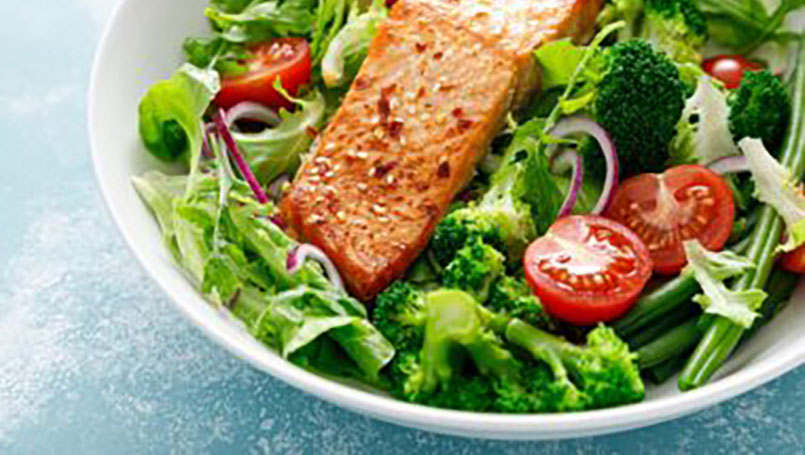Thursday, June 15, 2023

Your doctor says your blood pressure reading is too high.
So, what can you do to improve your numbers? Diet can be a powerful tool.
What the numbers mean
For most adults, an ideal systolic number is below 120 and the diastolic number should be below 80.
The systolic number is the top number. It measures the force the heart exerts on the walls of the arteries each time it beats.
The diastolic number, the bottom number, measures the force the heart exerts on the walls of the arteries between beats.
Depending on how far out of the ideal range your numbers are, your doctor may prescribe medications to lower your blood pressure.
But you can do a lot to lower your blood pressure to the point that you may no longer require medication–or avoid it entirely.
How? Diet matters, Kristi Veltkamp, RDN, a Corewell Health registered dietitian, said.
“One rule seems clear in most any diet: eat your vegetables. The Mediterranean diet and the DASH diet seem to be most popular and easiest to follow,” Veltkamp said.
Going Mediterranean
Research has shown that following the Mediterranean diet can not only lower blood pressure but may also prevent deaths from heart disease and cancer.
The Mediterranean diet includes nine food groups:
- Vegetables: 2 to 3 cups per day
- Legumes: 2 cups per week
- Fruits and nuts: 1.5 cups of fruit per day ; 0.25 cup of nuts per day
- Cereals and whole grains: 1.5 cups per day
- Fish: two 4-oz. servings per week
- Oils and fats: plant-based rather than animal fats
- Dairy: less than 1 cup (8 oz.) per day
- Meats: 1 serving (3-4 oz.) per day of lean pork, chicken, or grass-fed beef
- Alcohol: No more than one glass per day for women, two per day for men, with a meal
There are variations of the Mediterranean diet, but its general focus is increasing fruits and vegetables, Veltkamp said.
“You can’t go wrong with greens. Vegetables have natural nitrates that help to dilate blood vessels and keep them pliable,” she said.
Making a DASH for it
Another diet, the DASH diet, is probably the most popular pick her team sees for people wanting to improve their blood pressure, Veltkamp said.
“It is similar to Mediterranean but perhaps a little easier to follow. The main focus of DASH is to decrease our sodium intake–and the American diet can be very high in sodium.”
DASH stands for Dietary Approaches to Stop Hypertension. Hypertension is a medical term for high blood pressure.
“Blood pressure can be caused by too much sodium, but it can also be genetic,” Veltkamp said. “Our bodies regulate minerals through different hormonal processes. Some people are affected by sodium and some are not.”
The DASH diet recommends less than 2,300 mg of sodium per day–about one teaspoon.
“If you already have high blood pressure, DASH recommends 1,500 mg of sodium per day,” Veltkamp said.
The DASH diet includes eight food groups:
- Whole grains: six to eight servings per day
- Vegetables: five to six servings per day, fresh or frozen preferred
- Lean meats, poultry, fish, eggs: 6 oz. or less per day
- Fruits: four to five servings per day
- Low-fat or fat-free dairy: two to three servings a day
- Fats and oils: two to three teaspoons per day–olive, canola or butter
- Nuts, seeds and beans: four to five servings per week
- Sweets: five or fewer servings per week, 40 grams of sugar (or less)
“American diets tend to come up short on three important minerals for regulating blood pressure—potassium, magnesium and calcium—and the DASH diet builds on those,” Veltkamp said.
Fasting
“Both of these diets can help a person lose weight,” said Veltkamp. “Losing just 10 pounds can make a big difference in blood pressure numbers.”
Another way of taking off the pounds is intermittent fasting, or skipping meals entirely.
“There are many different ways of fasting,” Veltkamp said. “It can be hard to know which approach is best, but research has shown some residual benefits that include lowering blood pressure.”
One relatively simple approach to fasting is to have dinner earlier in the day and count the evening and night hours prior to breakfast the next day as a period of fasting, Veltkamp said.
The goal is to space at least 12 to 16 hours between meals.
Other approaches include following a typical meal schedule one day and fasting the next, alternating days. Or, eat normally five days a week and fast for two.
“There is some research that suggests that fasting can reduce inflammation in our bodies, and inflammation leads to many different kinds of diseases,” Veltkamp said.
Talking to your doctor about what kind of diet or fasting might work best for you is always a good way to begin your journey to better health, she said.
Your doctor can also refer you to a Corewell Health dietitian who can guide you to achieving your goals.
